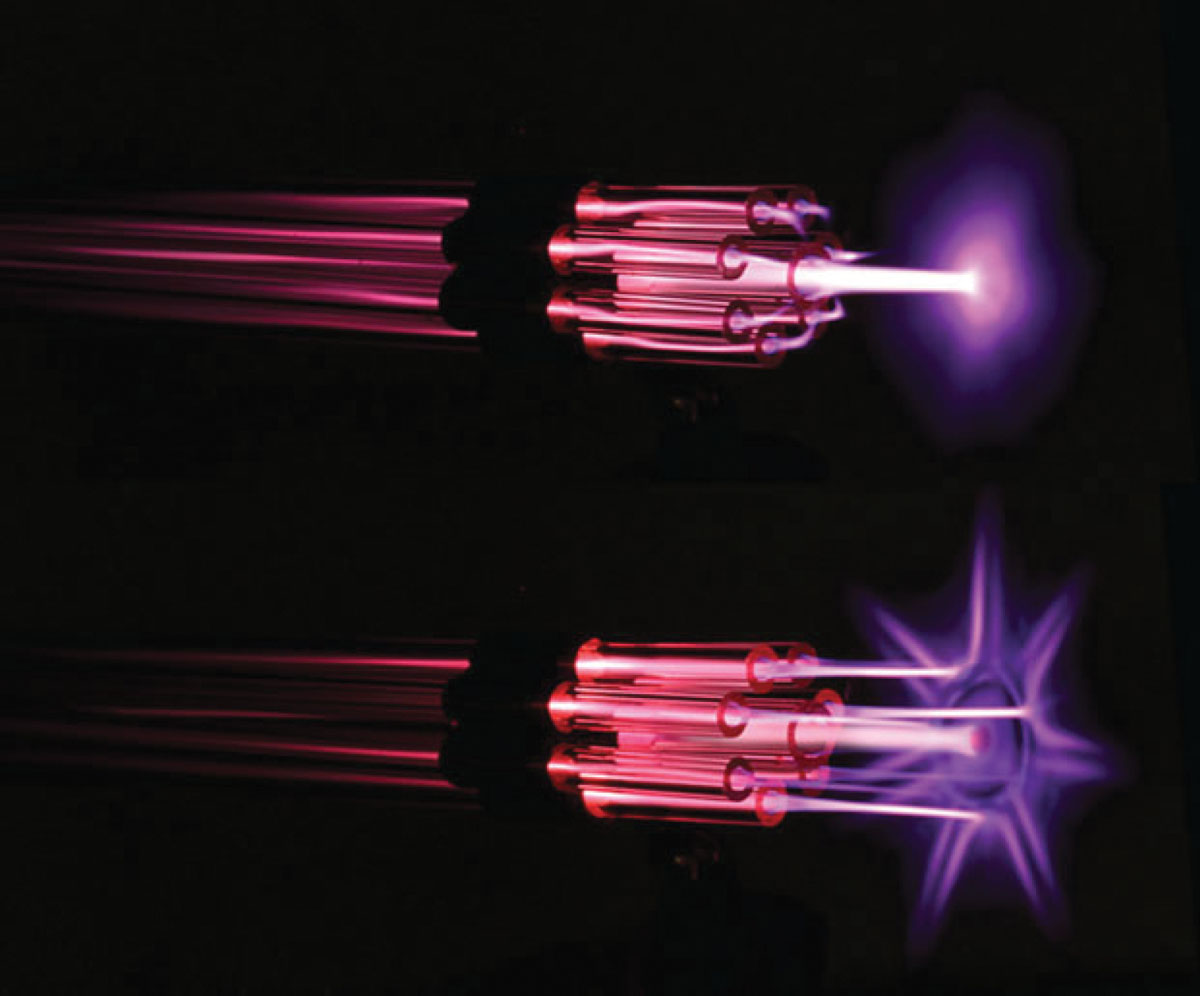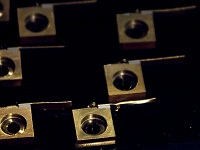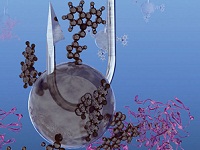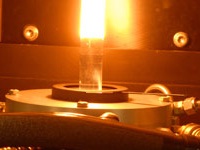aiming plasmas at cancer
stories by Neil Caudle
The hottest thing in medical science may be the gas-like stuff we see in stars.
Sung-O Kim came to COMSET to work on displays and wound up taking aim at cancer. Not that cancer is the lab’s only target. Kim and his students use plasmas to make all sorts of things. They make plasma thin films to sterilize wounds or medical equipment, or to shield the densely packed circuits on microchips. They make nanomaterials for flexible and transparent displays, solar cells, and batteries. And they conduct research in plasma physics, including plasma jet arrays that work under atmospheric pressure, eliminating the need for costly vacuum chambers.
 Using a hollow optical fiber to direct microplasma, Sung-O Kim’s lab demonstrated the ability to kill an individual cancer cell. (Illustration first published in Small, July 19, 2010, Wiley-VCH.)
Using a hollow optical fiber to direct microplasma, Sung-O Kim’s lab demonstrated the ability to kill an individual cancer cell. (Illustration first published in Small, July 19, 2010, Wiley-VCH.)But nothing grabs people’s attention like a brand-new therapy for cancer. And Sung-O Kim is almost there.
Before we talk specifics, let’s consider what a plasma is—the gas-like state of matter we see in stars or neon signs. Scientists and engineers make plasmas by heating a gas to ionize its molecules, or by exposing it to a strong electromagnetic field. A plasma television screen uses small cells of ionized gas to illuminate the image.
So the idea is to take that glowing, gas-like stuff, pipe it down a slender tube, and kill a tumor with it. Doctors have already used such plasmas on the outside of the body, to treat skin cancers. But Kim plans to take the treatment deeper. “We want to develop an endoscopic plasma device using optical fibers,” he says.
Endoscopes, which have tubes, lights, and lenses designed to probe around inside us, are already useful for examining organs and bodily cavities. But Kim’s endoscope would not just find the cancer cells; it would shut them down.
In the lab, Kim has shown that he can build a plasma device with such precision that it can snuff a solitary cancer cell—a feat that in 2010 and 2011 earned him the cover of Small, a leading journal in nanoscience. That sort of precision is possible because Kim’s lab has developed very slender tubes—some with an inner diameter of only four microns, much smaller than a cancer cell. In most cases, a surgeon would want to treat clusters of cells, and Kim’s device could do that too, he says.
“Sometimes in cancer treatment doctors, cannot use open surgery,” Kim says. “They could use our endoscopic device to treat the specific place where a tumor has grown.”
A similar technology has been tried in Europe, but the endoscope tubes there have been made of polymers that could degrade in contact with plasmas, Kim says. In fact, plasmas are very good at taking polymers apart. At COMSET Kim found ready access to glass-making equipment and expertise, and his collaborator, John Ballato, and he began to fabricate flexible tubing made of quartz glass, which Kim says is a much safer, more stable material for use in the body.
Kim’s collaborators at the Medical University of South Carolina have tested his technique in cell cultures and laboratory mice, and the team is working with a company in South Carolina to fabricate the endoscope for cancer treatments. Kim expects to see a device on the market “very soon,” he says.
Meanwhile, he and his collaborators have plenty of science to do. Because plasmas themselves are complex—a swarm of ions, electrons, photons, and phonons with various electrical and magnetic properties plus heat—it is difficult to understand them completely, especially when they interact with the complex biology of a cancer cell.
 Working with John Ballato, Kim’s team overcame the limits of atmospheric plasmas by coupling several jets into one powerful discharge. (Image first published in Plasma Processes and Polymers, March 2012, Wiley-VCH.)
Working with John Ballato, Kim’s team overcame the limits of atmospheric plasmas by coupling several jets into one powerful discharge. (Image first published in Plasma Processes and Polymers, March 2012, Wiley-VCH.)“We don’t know exactly why the plasma is killing cancers,” Kim says. “But we do know the most important thing: The plasma is initiating apoptosis.”
Apoptosis, also known as programmed cell death, is a normal process in cells that tells them when to die. When apoptosis fails, cancer spreads. Conventional chemotherapy kills cancer cells but usually inflicts collateral damage. Somehow, the plasma treatment flips a switch that tells a cancer cell to die in a couple of days but leaves normal cells alive.
“That’s why we don’t see any side effects from the plasma right now,” Kim says; “it’s based on apoptosis.”
At Clemson and other places, recent strides in plasma medicine and nanoscience are making people wonder where to look for the next generation of medical breakthroughs.
Are new drugs the answer, or will optics and materials science yield a better set of tools? Could the next big breakthrough in cancer therapy really come from Clemson?
Kim has thought about this question and the answer makes him smile. “Yes,” he says, “it could.”
This is what Eric Johnson has to explain, outside of work. But what he does make, with his team of savvy students, takes vision.
His was not the usual path to a job fighting cancer. Stephen Foulger was a California dude, a surfer and gear head who built motorcycles.
Fiber optics spread the Internet around the globe, but the science of light is just warming up. Go back to Material advantage and the power of light.
For now, we can introduce you to only a few of the people at COMSET, and we’ll have to save a number of researchers for issues to come. Or visit the COMSET website.
Sung-O Kim is an assistant professor in the Holcombe Department of Electrical and Computer Engineering in the College of Engineering and Science. His research is funded primarily by Samsung Advanced Institute of Technology and South Carolina Bioengineering Alliance.
The Office of Technology Transfer has filed a patent application for Sung-O Kim’s micro-plasma jet devices for biomedical applications.








